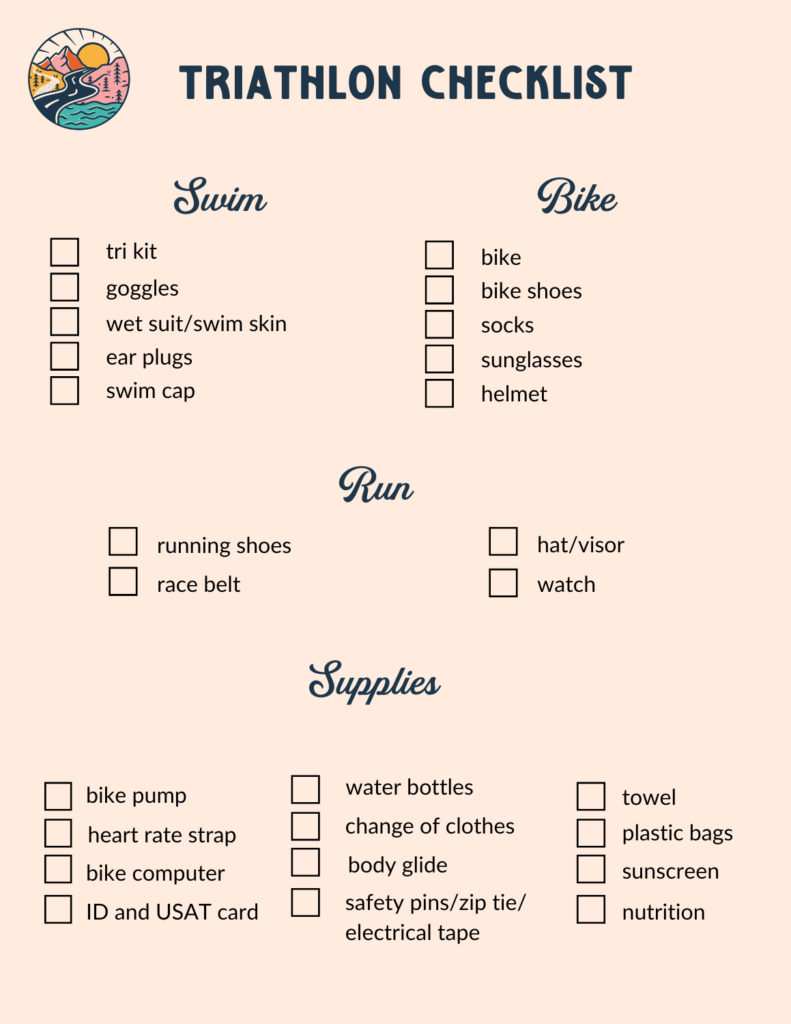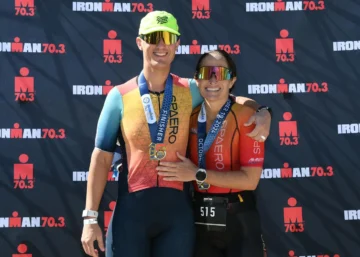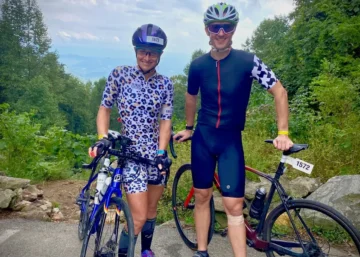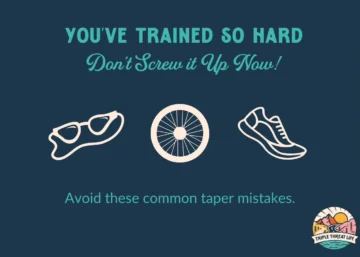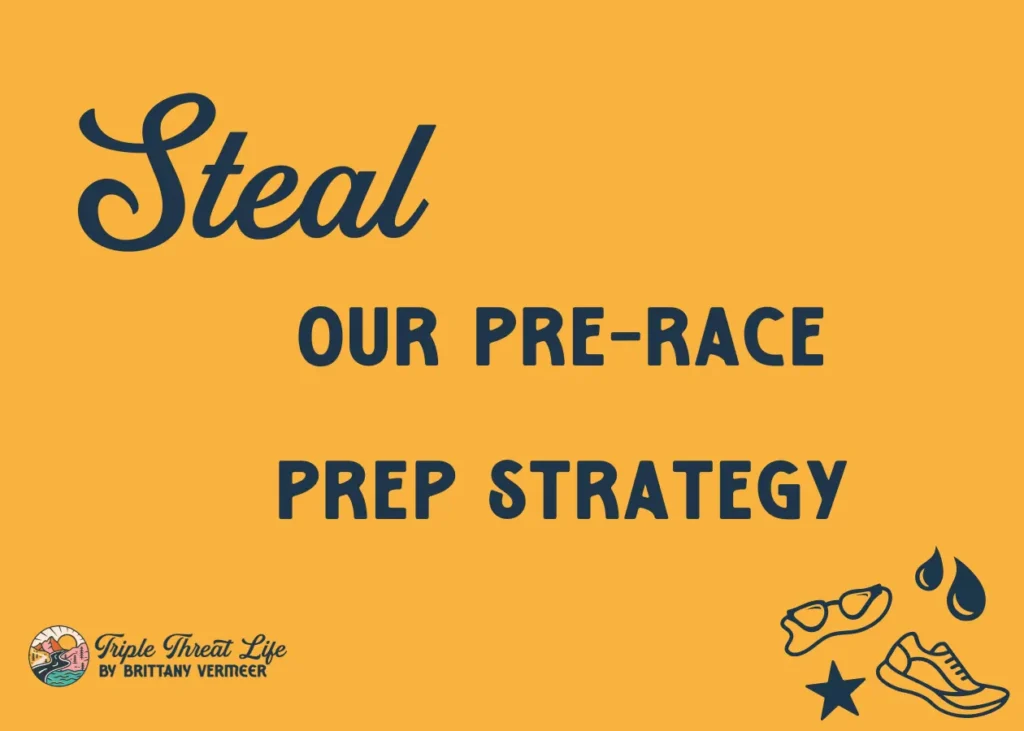
It’s race week! Always a busy time filled with pre-race workouts, checking and double checking our packing list, and making last minute preparations.
It can be hard to remember everything- what to pack, what to do, and when to do it. Although pre-race prep will vary depending on the race distance, we’ve developed a strategy over the past six years that works great for us.
And I’m going to share it with you!
For a bit of context, Matt and I are headed to St. Augustine for an Olympic distance triathlon this weekend. (1,600 yard swim, 24.8 mile bike, and 10K run). It’s our last opportunity for a bit of speed before we transition to long-course events in the fall.
Since the race is only three hours away, it’s logistically pretty easy. No flight to catch or bikes to pack. This race is a bit different because it’s on a Sunday, so we have an extra day of prep since most races take place on Saturday.
As far as race week training is concerned, every athlete is different. It depends on the race distance, your training load, and experience, but the basic rule of thumb is that some tapering is advised. Taper is simply a period where the training load decreases enough to provide your body with the ability to recover and be rested for the race.
You can probably guess that the taper period will be longer for longer races, like a 70.3 or Ironman, and shorter for a sprint and Olympic. We’re currently training for 70.3 North Carolina in October, so there’s a balance between maintaining higher mileage needed to prepare for that race, while also tapering slightly this week for the Olympic.
That’s where having a coach is helpful!
Our training schedule stays pretty much the same during race week, with a few minor adjustments. We typically swim and do strength in the gym on M/W/F and we bike and run on Tues/Thurs.
The main difference during race week is that we don’t do any strength, only mobility or light rehab if needed. The goal is to recover a bit, not create any additional muscle fatigue.
Some people like a bit more volume (me) and some prefer less, but regardless it’s not all easy workouts. There’s a bit of short intensity sprinkled in so the legs don’t feel dull on race day.
Race Week Schedule:
- Monday- Off day/swim
- Tuesday- Regular brick (bike/run)
- Wednesday- Swim
- Thursday- Shorter brick (bike/run) in complete race kit with all gear, check tires and charge bikes, computers, watches.
- Friday- Short swim, pack transition bags and nutrition (Most important sleep night)
- Saturday- Travel to race, hotel check in, and grocery store trip. Any last minute shake-out to check equipment. Cook dinner at home.
- Sunday- Race day!
You probably noticed that things look pretty normal until Thursday, and that’s when our race prep really begins. We always do the second brick of the week in our complete race kit- the trisuit, socks, shoes, and sunglasses we plan to use in the race.
We don’t train much in carbon-plated shoes, but we do race in them. This is the time to pull them out of the closet and do a short run off the bike, just to get used to the feeling and make sure the laces are adjusted how we want.
There’s a saying in triathlon- “Nothing new on race day.”
It might sound silly, but it’s worth reading, re-reading, tattooing on your chest, ect. Nothing new on race day applies to kit, gear, and nutrition.
It applies to technique as well. So you can bet when my husband was slipping out of his cycling shoes this morning experimenting with a flying dismount, he definitely got some side-eye…
Nothing New On Race Day Examples:
Running in a brand new pair of shoes? Nope.
What if they’re the same kind I always use? No. Shoes are always slightly different, even among size and model. You want to find out they cause blisters in training, not during a race.
The elastic laces, wetsuit, kit, nutrition I bought at the expo? Still no. If you haven’t used it during a training session, do not use it during a race.
I’ve never run without socks before, but someone told me it’s faster. NO. Going sock-less is faster, but you know what’s not faster? Ripping the flesh off the arch of your feet and hobbling to the finish line with blood seeping out of your shoes because you haven’t tried it before and it doesn’t work for you. Sorry for the image…
Try. It. In. Training. First.
Since Thursday is the last bike “workout,” it’s a good time to charge everything before it gets packed- bike computer, electronic shifting, watch, ect. TIP: Bring your Di2 charger with you, just in case your shifter gets pressed in transit and drains your battery.
I also like to give our tires a once-over to look for any small slits that could hold bits of gravel or pieces of glass and pick those out. (One time we saw that the side wall of Matt’s tire was failing, so we had to replace it before the race.)
If this was a 70.3 or Ironman, our bikes would’ve gone into the shop for a full race tune-up about a month prior. They check things like shifting cables, brakes, tighten bolts, ect. Sometimes we need a new chain or cassette, and we will have ordered it ahead of time.
During our last long ride outside (the previous Saturday) is when we make sure our heart rate strap, cadence sensor, and power is synced and showing up correctly on our bike computers. We also wash our bikes and put lube on the chains.
Friday is for packing transition bags. But before we pack, we always do a bit of transition practice. We lay out T1 (swim-bike) and practice putting on socks, cycling shoes, helmet, and sunglasses. Then, we do T2 (bike-run) by taking off cycling shoes, helmet, and sunglasses and putting on running shoes, grabbing race belt, sunglasses, and hat. We time ourselves to see how fast we can get!
We have a packing list that our coach gave us years ago when we first started, and we still use it to this day. It includes swim, bike, and run gear as well as clothing, nutrition, tech, and extra bits.
We spread out everything on the living room floor and check items off the list. Then, we do a second time. It’s important to physically see everything you’re packing and not just assume that your socks, heart rate strap, energy gels are somewhere in the bag.
Also, don’t forget your USAT card and ID, which are needed for athlete check in.
You can download a FREE PDF of our packing list at the bottom of this post. 🙂
Consider things you might need if you’re traveling to a race like sunscreen, chamois cream, medications, inhaler, foam roller, compression boots, massage gun, ect.
In addition to race nutrition, also think about pre-race electrolytes or a post-race protein shake. We drink a bit more electrolytes in the two days prior to a race, so we need to pack that too. We like LMNT- grapefruit, but we’ve also used Liquid I.V. you can get at Costco.
If this was a 70.3 or Ironman, we would’ve checked to see if we had enough race nutrition about a month out, so we could order more if needed. TIP: My coach puts a reminder in my Training Peaks, because she’s awesome, but you can set an alarm on your phone too. For ordering nutrition, charging your bike, ect.
Two days before the race is the most important night for sleep. I learned this from my coach!
Many of us have a hard time sleeping the night before the race, so make sure to get a good night’s sleep two nights before the race, and you’ll be just fine.
Two days out is a good time to review any race emails you might have received and look at course maps. I like to print out a hard copy of any race instructions with addresses or important dates and times we need to remember.
If we’re staying at a hotel or Air BNB, we get information about check-in and check-out times. This is important if you plan to take a shower before you drive home… Some hotels will give you a late check-out if you ask nicely.
Once we get to the race venue, we check-in to the hotel, unpack, and head to the grocery store to pick up food to cook for dinner and breakfast. We resist the urge to eat out the night before a race in favor of cooking so we can control exactly what we’re eating. We save eating out for post-race celebrations.
If it was a long drive, we might go for a walk, short run, or short spin to shake everything out and make sure the bikes are working properly. Then, it’s time to kick up our feet and relax in our compression boots while watching a movie or reading a book.
The last thing we do before bed is set out everything we need for the morning. We decide what time we need to wake up so we can get ready and arrive in transition on time. We like 1 hour at least prior to the race start time to park, set up transition, do a warm up run or swim, and walk through the flow of transition.
Now you’re ready to race!
I hope our Pre-Race Prep Strategy helped ease any anxiety you might have about race week. Don’t worry, everyone gets nervous.
I find that having a well-laid out plan helps me feel calm knowing that I’m in control of my pre-race preparations.
Ultimate Triathlon Packing List
